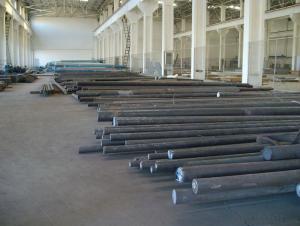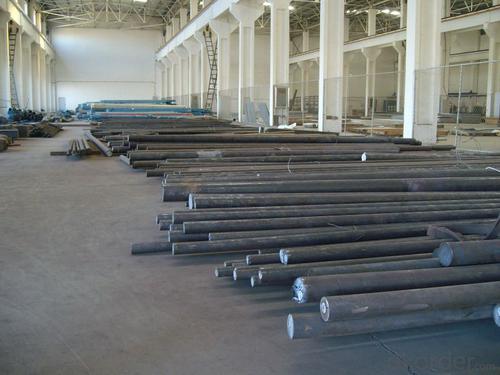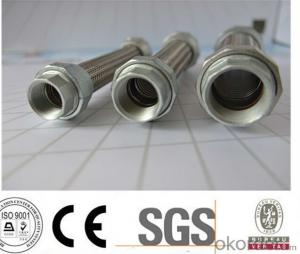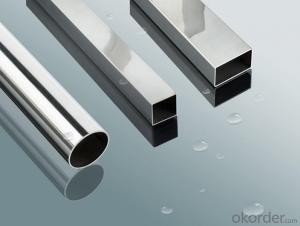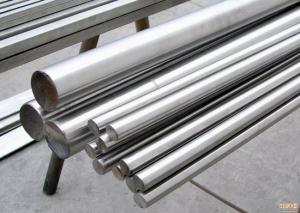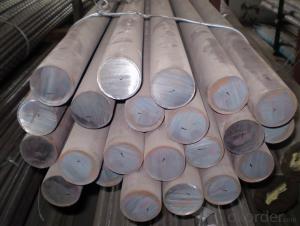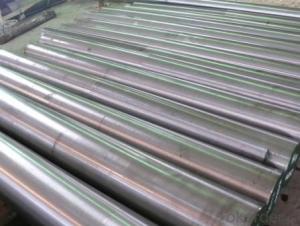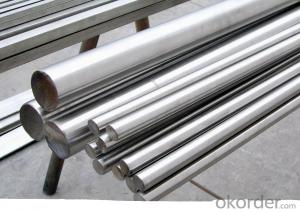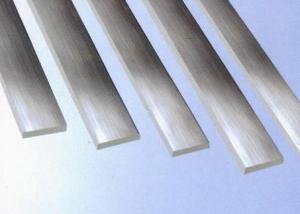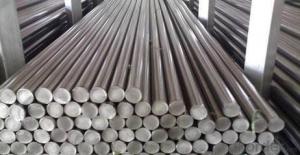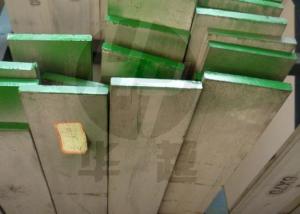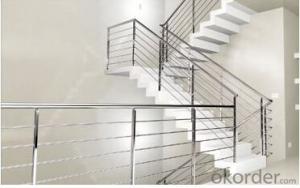316L Black/Acid/Bright/Grinded stainless steel bars
- Loading Port:
- Tianjin
- Payment Terms:
- TT OR LC
- Min Order Qty:
- 100 kg
- Supply Capability:
- 1000 kg/month
OKorder Service Pledge
Quality Product, Order Online Tracking, Timely Delivery
OKorder Financial Service
Credit Rating, Credit Services, Credit Purchasing
You Might Also Like
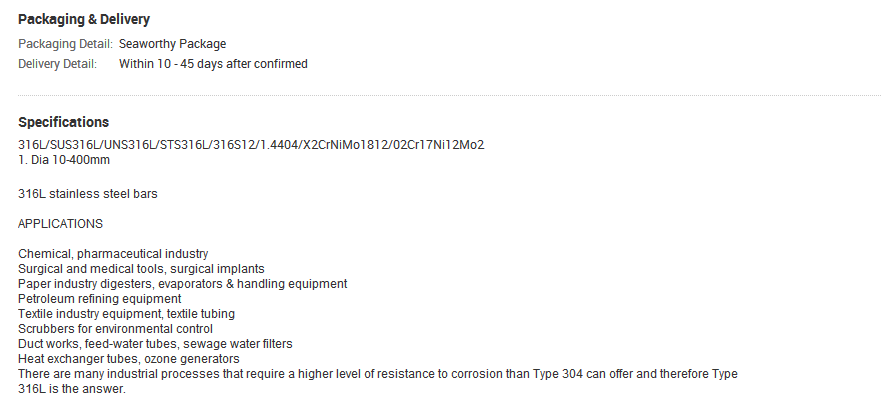
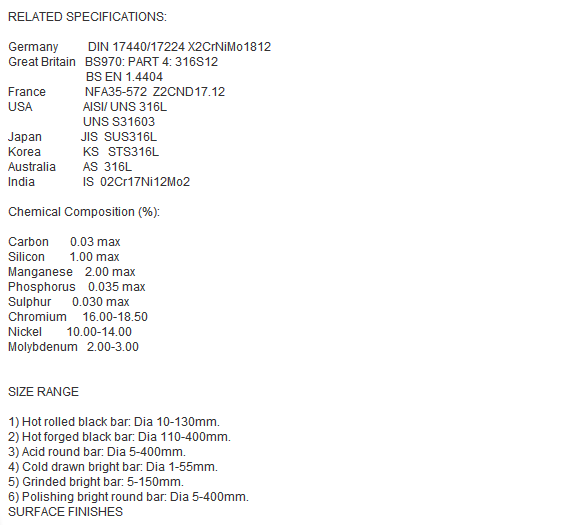
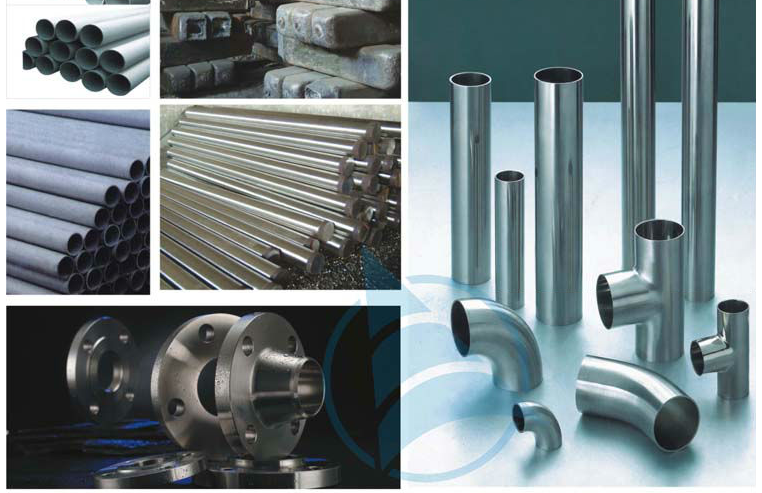
- Q: Are stainless steel pipes suitable for underground drainage systems?
- Yes, stainless steel pipes are suitable for underground drainage systems. Stainless steel is highly durable, resistant to corrosion, and has a long lifespan, making it an excellent choice for underground applications where the pipes may be exposed to moisture, chemicals, and other harsh conditions. Additionally, stainless steel pipes offer high strength and are capable of withstanding heavy loads, making them a reliable option for underground drainage systems.
- Q: How do you insulate stainless steel pipes?
- One way to insulate stainless steel pipes is by using insulation materials such as foam pipe covers or fiberglass pipe insulation. These materials can be wrapped around the pipes to provide a layer of insulation and prevent heat loss or condensation. Additionally, using insulation tape or adhesive can help secure the insulation in place.
- Q: Are stainless steel pipes more expensive than other types of pipes?
- Generally speaking, stainless steel pipes tend to be pricier compared to other pipe variants. This can be attributed primarily to the expensive raw materials utilized in their production, along with the intricate manufacturing procedures involved. In addition, stainless steel pipes boast numerous advantages over alternative options, including exceptional resistance to corrosion, heightened durability, and the capacity to withstand extreme temperatures. These factors collectively contribute to their elevated price range. Nevertheless, for many applications, the long-term benefits and superior performance of stainless steel pipes often outweigh the additional cost, justifying their investment.
- Q: Can stainless steel pipes be used for solar water heating systems?
- Stainless steel pipes, indeed, have the capability to serve in solar water heating systems. The reason behind this popularity lies in the durability, corrosion resistance, and high-temperature endurance exhibited by stainless steel. Its suitability for enduring the challenging outdoor circumstances and constant exposure to sunlight encountered by solar water heating systems is noteworthy. Moreover, stainless steel pipes are renowned for their long-lasting nature, rendering them a perfect option for prolonged utilization in solar water heating systems. All in all, stainless steel pipes provide exceptional performance and reliability for solar water heating systems.
- Q: What are the common applications of stainless steel pipes?
- Due to their exceptional qualities, stainless steel pipes find widespread use across various industries. They are highly regarded for their corrosion resistance, durability, and ability to withstand high pressure and temperature. Here are some of the common applications of stainless steel pipes: 1. Plumbing and Water Systems: Stainless steel pipes are commonly employed in plumbing and water supply systems due to their ability to resist corrosion, durability, and capacity to handle high pressure and temperature. 2. Oil and Gas Industry: The oil and gas industry heavily relies on these pipes for the transportation of petroleum products. This is because stainless steel pipes exhibit high resistance to corrosion and possess excellent strength, enabling them to endure extreme temperatures and harsh conditions. Consequently, they prove ideal for offshore drilling and pipeline systems. 3. Food and Beverage Industry: The food and beverage industry extensively utilizes stainless steel pipes for the transportation of liquids and gases. These pipes are favored for their hygienic properties, resistance to corrosion, and ease of cleaning. They are frequently employed in dairy plants, breweries, and food processing units. 4. Pharmaceutical Industry: In the pharmaceutical industry, sterile conditions are essential when transporting chemicals, gases, and liquids. Stainless steel pipes are indispensable in this sector due to their corrosion resistance and capability to withstand high temperatures. 5. Construction and Architecture: Stainless steel pipes serve a multitude of purposes in construction and architecture, particularly for structural applications. They are utilized for handrails, balustrades, structural supports, and decorative elements. The aesthetic appeal, durability, and corrosion resistance of stainless steel pipes make them highly sought after. 6. Automotive Industry: The automotive industry relies on stainless steel pipes for numerous applications, including exhaust systems, fuel lines, and structural components. The high temperature resistance and durability of stainless steel make it a suitable choice for these demanding tasks. 7. Chemical Industry: The chemical industry extensively employs stainless steel pipes for the transportation of corrosive chemicals and gases. Their resistance to corrosion and ability to withstand high temperatures make them well-suited for chemical processing plants and refineries. 8. Marine Industry: The marine industry extensively utilizes stainless steel pipes due to their ability to resist corrosion caused by saltwater. They are crucial components in shipbuilding, offshore platforms, and underwater pipelines. Overall, stainless steel pipes are invaluable in industries that prioritize corrosion resistance, high temperature resistance, durability, and hygiene. Their versatility and reliability have made them the preferred choice across various industries worldwide.
- Q: What is the difference between sanitary and industrial stainless steel pipes?
- Sanitary and industrial stainless steel pipes differ primarily in their intended use and the level of cleanliness required. Sanitary stainless steel pipes are specifically designed for applications in the food and beverage industry, pharmaceutical industry, and other sanitary environments where cleanliness and hygiene are of utmost importance. These pipes are manufactured with a higher level of surface finish, typically a smooth and polished surface, to prevent bacteria growth and ensure easy cleaning. The inner surface of sanitary pipes is often electropolished to further enhance its smoothness and resistance to corrosion. Additionally, sanitary pipes are often equipped with tri-clamp fittings or other sanitary connections to facilitate easy disassembly for cleaning purposes. On the other hand, industrial stainless steel pipes are used in a wide range of applications, including manufacturing, oil and gas, chemical processing, and construction. These pipes are typically designed to withstand high pressures, extreme temperatures, and harsh environments. Industrial pipes may have a rougher surface finish and may not require the same level of cleanliness as sanitary pipes. They are often welded or threaded together for assembly and are built to withstand heavy-duty usage. In summary, the main differences between sanitary and industrial stainless steel pipes lie in their intended use, surface finish, and level of cleanliness required. Sanitary pipes prioritize hygiene and ease of cleaning, making them suitable for food and pharmaceutical applications. Industrial pipes, on the other hand, focus on durability and strength to withstand demanding industrial environments.
- Q: What are the common standards for stainless steel pipes?
- Stainless steel pipes have varying common standards depending on the specific application and industry in which they are used. However, there are several widely recognized standards that are commonly employed in the manufacturing and specification of these pipes. One of the most extensively used standards is ASTM International, which is responsible for establishing standards for various materials, including stainless steel. ASTM A312/A312M serves as the standard specification for austenitic stainless steel pipes that are seamless, welded, and heavily cold worked. This comprehensive standard encompasses a wide range of pipe sizes and grades, including TP304, TP316, TP321, and more. Another standard frequently referenced is the American National Standards Institute (ANSI) standards. ANSI B36.19 specifically delineates the dimensions, tolerances, and materials for stainless steel pipes. This standard covers both seamless and welded stainless steel pipes, offering a multitude of sizes and schedules. Apart from these standards, there are also industry-specific standards. For instance, the American Petroleum Institute (API) has established standards like API 5L, which are specifically designed for line pipes used in the oil and gas industry. These standards outline the requirements for materials, dimensions, and testing of stainless steel pipes utilized in specific applications. Other standards organizations, including the International Organization for Standardization (ISO) and the European Committee for Standardization (EN), also contribute their own standards for stainless steel pipes. ISO 1127, for instance, specifies the dimensions and tolerances for stainless steel pipes used for general purposes. It is important to acknowledge that these standards are continuously updated and revised to align with technological advancements and industry requirements. Therefore, it is crucial to refer to the latest versions of these standards to ensure compliance and maintain the quality of stainless steel pipe manufacturing and usage.
- Q: Are stainless steel pipes suitable for hydraulic applications?
- Stainless steel pipes are indeed suitable for hydraulic applications. Renowned for their outstanding resistance to corrosion, stainless steel proves ideal for hydraulic systems that may encounter different fluids. With their impressive strength and durability, stainless steel pipes can withstand the high pressure and temperature conditions commonly found in hydraulic systems. Moreover, these pipes offer exceptional dimensional stability, maintaining their shape and integrity even during extreme operating conditions. Thanks to their corrosion resistance, stainless steel pipes boast a longer service life compared to alternative materials, reducing the necessity for frequent replacements and maintenance. All in all, stainless steel pipes represent a trustworthy and effective option for hydraulic applications.
- Q: How do you calculate the heat transfer coefficient of stainless steel pipes?
- The heat transfer coefficient of stainless steel pipes can be determined through a variety of methods, including empirical correlations and theoretical calculations. One popular empirical correlation is the Dittus-Boelter equation, which establishes a relationship between the heat transfer coefficient, Reynolds number, and Prandtl number. The equation is as follows: Nu = 0.023 * Re^0.8 * Pr^0.4 In this equation, Nu represents the Nusselt number, Re represents the Reynolds number, and Pr represents the Prandtl number. The Nusselt number is a dimensionless quantity that signifies the ratio of convective to conductive heat transfer. To calculate the Reynolds number, the following formula is used: Re = (ρ * v * D) / μ Here, ρ denotes the fluid's density, v represents the fluid's velocity, D is the hydraulic diameter of the pipe, and μ represents the fluid's dynamic viscosity. The Prandtl number can be determined using the equation: Pr = μ * Cp / k In this equation, Cp stands for the specific heat capacity of the fluid, while k represents the fluid's thermal conductivity. Once the Reynolds and Prandtl numbers are determined, they can be substituted into the Dittus-Boelter equation to calculate the Nusselt number. Finally, the heat transfer coefficient can be obtained by multiplying the Nusselt number by the fluid's thermal conductivity and dividing it by the hydraulic diameter of the pipe: h = (Nu * k) / D In this equation, h represents the heat transfer coefficient. It is essential to note that these calculations are based on assumptions and empirical correlations. Actual heat transfer coefficients may vary due to factors such as pipe roughness, fluid properties, and flow conditions. Therefore, it is advised to consult relevant heat transfer literature or conduct experimental studies for more precise results.
- Q: Can stainless steel pipes be insulated with polyethylene-co-vinyl acetate?
- Indeed, it is possible to insulate stainless steel pipes with polyethylene-co-vinyl acetate (PEVA). PEVA is widely utilized as an insulating substance owing to its remarkable thermal insulation characteristics. This material is both flexible and long-lasting, allowing for easy application to stainless steel pipes for insulation objectives. PEVA insulation contributes to the prevention of heat loss or gain, diminishes energy consumption, and furnishes protection against condensation. Furthermore, PEVA exhibits resistance against moisture, chemicals, and UV radiation, rendering it suitable for outdoor applications. Consequently, employing PEVA as insulation for stainless steel pipes presents a feasible alternative.
Send your message to us
316L Black/Acid/Bright/Grinded stainless steel bars
- Loading Port:
- Tianjin
- Payment Terms:
- TT OR LC
- Min Order Qty:
- 100 kg
- Supply Capability:
- 1000 kg/month
OKorder Service Pledge
Quality Product, Order Online Tracking, Timely Delivery
OKorder Financial Service
Credit Rating, Credit Services, Credit Purchasing
Similar products
Hot products
Hot Searches
Related keywords
